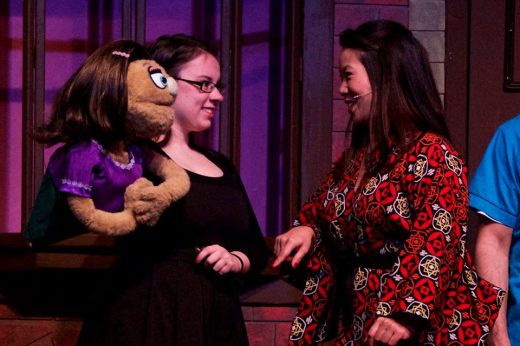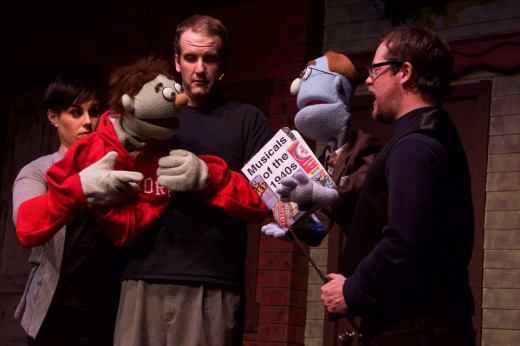As the Brewster sisters served up their infamous elderberry wine with their killer secret ingredient – arsenic – at their boarding house in New London-based Flock Theatre’s closing weekend of “Arsenic & Old Lace,” patrons drank in some Connecticut history.
There’s a fine line between normalcy and insanity, as well as reality and theatrics, in Joseph Kesselring’s play inspired by real life serial killings at a Windsor, Connecticut home for the elderly, nicknamed the “Murder Factory,” where a woman named Amy Duggan Archer Gilligan was poisoning her boarders for their penchants.
Mortimer Brewster (Eric Michaelian) is a begrudged theater critic (the Cary Grant character in the 1944 film by the same name) who is engaged to the love of his life, Elaine Harper (Amy Bentley), the beautiful girl living next door to his sweet aunts, Abby Brewster (Suzanne McCormick) and Martha Brewster (Denise Shutzman). On the day he reveals the news of his upcoming nuptials to his loving aunts, he unearths a major skeleton (or 12) in their closet (or their window seat and basement).
They are poisoning boarders, specifically men, with arsenic-laced elderberry wine and burying them in graves dug by his crazed yet lovable uncle, Teddy (Bill Steinmayer), who thinks he’s President Theodore Roosevelt digging locks in the Panama Canal and burying yellow fever victims. Mortimer begins questioning his own sanity as he deals with his deluded family. The gravity of the situation later intensifies when his terrifying, murderous and multi-“face”-ted brother, Jonathan (Mark Sullivan) returns home.
Flock created an intimate setting by staging the play in a small room in Shaw Mansion, New London County’s historical society headquarters on Blinman Street.
The show was so popular and the space was so small that it sold out closing weekend, so Flock added a Saturday matinee. A few rows of audience members sat close to the action happening just a few feet before our eyes on Saturday. In having us sit in the dining room of a real house, we are invited into what feels like an actual boarding home and are kept in close proximity to the story like we are part of it. The actors brushed by us in their aisle entrances making it so real and allowing us to feel the energy even more. It makes the play more relatable and meaningful.
The tight room also makes the actors’ reactions, emotions and expressions even more pertinent because the audience is so close and their every movement is more noticeable. For instance, you could detect nerves if an actor’s hand was shaking while holding a teacup and saucer and it was noticeable when actors broke character by making eye contact with audience members. Actors occasionally stuttered lines, which may not have been as audible in a theater, but they quickly recovered so it didn’t detract from the performance. That imaginary fourth wall between the actors and audience goes away when you’re so close to the action, just like theater in the round, so it takes even more concentration on the actors’ parts to play to the audience and connect without seeming to be aware of the people watching. It’s a challenging task.
However, for the most part, the close setting worked in the Flock company’s favor because the cast was very strong.
You could also hear their raw voices without the need for audio enhancement or microphones. As actors also shouted lines from other rooms in the mansion, it added more depth to the simplistic set to portray the illusion of other rooms we never see in the boarding house.
It breathed more comedy into Steinmayer yelling “charge” every time he leaves the room or blaring his bugle for “cabinet meetings” because the booming sound exaggerates Teddy’s eccentricities even more. Steinmayer’s look and mannerisms are even more distinct close up, so he was recognizable as his character’s Teddy Roosevelt persona before anyone even addressed him as such. He does a “bully” good job in that role.
Bentley achieves something very difficult in the world of theater. She goes beyond a character saying lines and delivers us a character who’s so real to the point you almost forget she’s an actress playing a role. The believability of her character is a credit to the raw emotions she pours into Elaine in how she connects with other characters. Her chemistry with Michaelian was particularly strong. Her loving and searching eyes as she makes eye contact with him so genuinely portrays her character’s love for Mortimer as he pulls away from her to protect her in dealing with his aunts’ murders and the reappearance of his dangerous brother, Jonathan. You can relate to her really easily.
Michaelian says a lot even when he’s saying nothing at all as Mortimer. The expressions in his eyes and on his face, as well as his exasperated reactive noises that emote shock more than words can, show us the complexity of his characters’ thoughts, emotions, reactions and motivations. Mortimer isn’t always able to say what he’s thinking because he’s a sane person processing what he deems to be insane in his family lineage as he worries he faces the same fate. As he grapples with morality and understanding of his family’s insanity, his words put on a truth-concealing layer of protectiveness for his aunts and fiancée as a front to bide time for him to figure out how to act. All the while, his instincts are frantic and we can read even deeper into his character’s internal conflicts in seeing the contrast between his lines and reactions. His initial discovery of a dead body in the window seat, revealing his aunts’ dark secret, is hilarious and priceless, drawing us into his shock even more so than if he just told us how he felt.
Similarly the aunts’ sweet, innocent and respectable demeanor juxtaposed against their actions of murdering 12 men with poison wine serves us comedy with a twist. McCormick and Shultzman are so pleasant, nonchalant and calm when they explain to Mortimer how they help men achieve a peaceful end without suffering that it lightens the mood with humor in contrast to the horrible deeds to which they are confessing. Instead of growing alarmed in their honesty or worrying about the repercussions, we see that they think their reasoning is rational, which is perhaps even more terrifying to Mortimer.
Sullivan’s character is very important in redirecting the story by upping the ante. He too has killed 12 people, bringing in another body to add to the window seat and “Panama Canal.” He also speaks matter-of-factly about his killings with a Donald Sutherland look and air about him, but we judge him more than the aunts because of his foreboding personality and stature and the graphic, horrific nature of the murders. Just don’t call him Boris Karloff. He’s sensitive about that.
Alex Kydd was another comic standout with his German accent as the quirky Dr. Einstein who gives Jonathan new faces, proving that appearances can be deceiving. A lot of characters put on fronts and faces, but Jonathan literally changes his.
Throughout the story, Mortimer grows increasingly more concerned about his own sanity to the point where he wonders if he should subject Elaine to marrying him. If his family is crazy, will he eventually become insane?
The play calls into question the definition of insanity. The Brewster sisters and Jonathan are arguably the most insane in their actions of serial killing and being okay with it, yet they are also the characters who are the least frightened and the most calm in talking about what they’ve done. Teddy may be defined as the crazy one in the play, but Mortimer is fine with him taking the rap for his aunt’s indiscretions, in fact coming up with that plan because it’s easier to justify the murders in his mind by blaming it on someone’s insanity as opposed to accepting his aunts are at peace with it. Yet, his aunts don’t want Teddy to take the blame and don’t believe the police will trouble themselves with all the paperwork of explaining all the dead bodies in their cellar.
Teddy’s world is delusional because we obviously know he isn’t really the president of the United States, there is no yellow fever plaguing the Brewster boarding house and there is no Panama Canal in the basement. But “insanity” is an easy and understandable explanation for his abnormal actions. Mortimer is more alarmed by his aunts’ reality of killing than Teddy’s fiction.
The characters who are supposed to be the most sane are sometimes the ones who act the most irrationally. Elaine is bewildered when Mortimer goes from proposing to her one minute and throwing her out of the house the next as he runs around like a crazy person, frantically trying to figure out what to do.
Then there’s the police, who are supposed to be the prevailers of justice by punishing lawbreakers. Yet they can’t see what’s right in front of them when faced with criminality, perceiving truth as unrealistic. Teddy, the supposedly crazy one, is one of the first to tell them about the dead bodies in the basement, but they don’t believe him. They just write it off as crazy and don’t want to risk digging up the basement just because of what could be delusions. Then, when the aunts tell them, they still don’t believe them because they are pillars in the community and perception blinds them. When it comes down to it, Lt. Rooney (Malcom Cameron) and the officers just don’t want to deal with it, true or not.
And when Jonathan and Dr. Einstein tie Mortimer up and gag him in preparation to torture and kill him, Officer O’Hara (Nick Perry) happens upon it and thinks it’s Mortimer just acting out a scene from a play in a comical moment of dramatic irony made possible by the enthusiasm in Perry’s delivery. Rather than seeing it for what it is and rescuing Mortimer in his role as a police officer, he thinks it’s all play and as an aspiring playwright proceeds to tell the bound and gagged theater critic about his big story idea for his own script. Then when two more police officers (Stephen Breaux and Zach Amanti as Officers Klein and Brophy, respectively) barge into the home, they are more focused on addressing noise complaints about the bugle playing of a crazy man, Teddy, than completely grasping the severity of the situation. Sure, they do happen upon Jonathan and recognize him as a wanted man, but it still isn’t a focus for them.
Theatrical references are woven throughout the script despite the fact that Mortimer hates the theater. Theater becomes a metaphor for insanity versus reality, particularly in the scene where Mortimer criticizes the stupidity of a theatrical victim falling into harm’s way despite his intelligence as the very same thing is happening before our eyes as Jonathan creeps up behind him to capture him. In the same way, he can’t accept the possibility of insanity being in his life, so it comes as a great relief to him and Elaine when he finds out he isn’t really biologically related to any the Brewsters. Yet theater represents reality more than he realizes.
The Hartford Courant broke the real-life story of Amy Duggan Archer Gilligan that inspired the play, dubbing her Windsor home for the elderly, the “Murder Factory,” according to connecticuthistory.org/windsors-murder-factory. Two of her husbands died, as well as 60 residents of her boarding house between 1907 and 1916, according to the website. Authorities eventually dug up dozens of bodies from the property and discovered traces of arsenic with them, ultimately leading to her conviction and placement in a Middletown state mental hospital due to the legal determination she was “insane,” the website reports.
Similarly, the Brewster aunts resolve to go to a home for the insane with Teddy. Under the guise of insanity, they are never really punished for their crime and are content. Yet Jonathan is arrested and imprisoned. There is no right and wrong or black and white in this play.The funny part about the ending is that the aunts have to outshine Jonathan and “win” by killing one more person than him as we see them about to poison one more man, Mr. Witherspoon (George Dowker), the superintendent of the home for the mentally insane. The three Brewsters are all murderers, yet they don’t face the same consequences. Are the aunts’ serial killings on a different plain than Jonathan’s murders?
It’s part of the dramatic irony and questions that makes the play all the more comical for a sensible audience that has all the information about the nonsensical plot that unfolds.
Michaelian was part of the Flock team who discovered the Connecticut connection to “Arsenic & Old Lace.” When the theater company learned of the historical relevance of this play to our state, they chose to add it to their lineup.
The historical significance to Connecticut made it a perfect example about how theater can be both real and insane, ultimately making us think as we escape into the story while grasping the features that we can relate to the most.
Fore more information about Flock Theatre, visit www.flocktheatre.org or “like” the theater company on Facebook at facebook.com/flocktheatre.
























